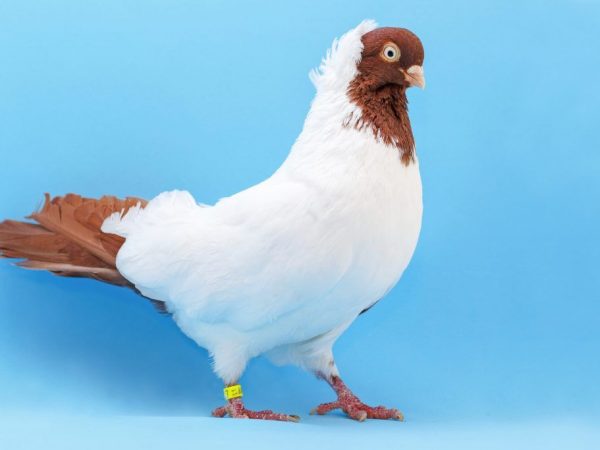Characteristics of Monks pigeons
Among the variety of species of pigeons tamed by people for a long time, the ancient Monk breed stands out. These birds are popular among amateurs and those who professionally breed birds. The peculiar appearance and exquisite demeanor of these winged ones are noticeable not only in life, but also in the photo. So, pigeons Monks - what are they?

Doves Monks
A bit of history
Back in the distant 17th century, a breed was bred in Germany, which immediately received the name German Monk. There are two versions of the origin. According to the first, the reason was the appearance, which resembles the attire of monks. The second option says about the independence of the species and the desire to fly alone. Over time, the name of the breed was supplemented with the word "cross", because if you look at the flight from below, the open wings of the Monkhs resemble a cross.
It is difficult to find purebred Cross Monks these days. The degeneration of the species occurs due to numerous crosses for the sake of improving the breed.
The recognition of such birds is possible due to their unique appearance.
There are 2 types of Cross Monks: German and Moscow. They are very similar to each other, but have different colors of feathers: from brown and silver to reddish and blue.
a brief description of
A monk has the following characteristics:
- the main feature is considered a crest on the back of the head made of thick white feathers;
- strong body 35 cm long;
- elongated body, slightly tilted forward;
- legs devoid of plumage;
- small eyes with a movable black pupil;
- a forehead that turns into a delicate little beak 15 mm long;
- graceful neck, blending smoothly into the body;
- a spectacular crest, which is considered to be a sign of a purebred breed;
- developed wide chest;
- long wings pressed against the body;
- medium-sized tail of 12 tail feathers;
- a light-colored body, which is decorated with a tail of a different color, a cap on the head, which is yellow, black and coffee;
- they can fly at low altitude and not for long.
Pigeons Monks differ from other brethren by the contrast of a white body with a dark head and tail. The bird is extremely friendly and when it sees other pigeons flying by, it hurries to meet them and calls to the flock. In any photo, you can see the proud posture and gracefulness of the birds' flight. In addition, the Monk is incredibly resistant to external influences and hardy.
Specificity of subspecies
Now let's find out how the German Monk and the Moscow Monk are different. Both those and others have a crest. But Moscow Monks were bred quite recently: in the twentieth century. They are snow-white, like all Cross Monks, but differ in the color of the feathers on the crest: if the German subspecies is recognizable by brown plumage, then the Moscow one can have from black to reddish-yellow hue. In addition, birds have a body beak with a brown “cap” and a coffee tail, while those with a black one have a white beak. The Altai Monk is distinguished by its grace and the fact that the crest can be of any color.
Individual characteristics prevent pets from making long flights and getting too high off the ground. The winged ones skillfully create a flock and in it they keep quite close to each other. Jumping pigeons stand out against the general background. Such individuals sit on the roof for half a day, but when they see strangers they rush towards, as if calling to join them. Bird breeders deservedly consider them the most calm and affectionate among their own kind.
The Cross Monks are clean and friendly, attached to people and unpretentious to living conditions. Caring for them will not take much time and effort. They are very good parents and take good care of their offspring. Breeders use their parental qualities and use them to feed chicks of other breeds, even more valuable. Proper care will ensure that you get 3 or even 4 broods in one summer.
The Cross Monk should be kept in a special poultry house and be constantly provided with high-quality, balanced feed. Individuals are omnivorous and resistant to various diseases. When planning to acquire representatives of this rare breed, it is important to know that there will be no hassle and special expenses.
What are the signs of the lack of purity of the breed?
Many people often simply admire decorative beauties in life and in photos, not paying attention to small details. The German monk is a pigeon with minor flaws, indicating a mixed breed:
- dark claws;
- short wings;
- sunken chest;
- shorter than 15 mm beak;
- short legs;
- too wide tail with a few light feathers.
But this list of defects is not as critical as the following: a light tail, the absence of a tuft or its insufficient density, feathers on the legs, a small body, white stripes on the head, a large beak, a head that is too large, an iris of a reddish or yellow tone, snow-white stripes on the head. Such birds are not allowed to participate in exhibitions.
All owners of representatives of this endangered breed are guaranteed the joy of admiring them. As the saying goes, who can prohibit "getting blue" next to such handsome men on the farm?


